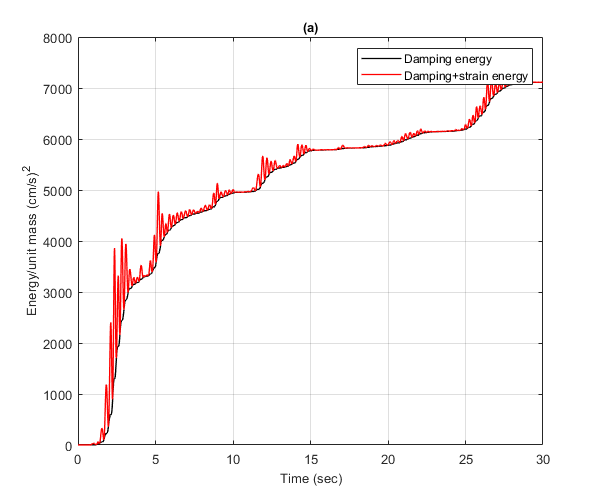verification Energy time history of SDOF oscillator
Calculate the time history of the strain energy and the energy dissipated by viscous damping and yielding of a linear and a nonlinear SDOF oscillator
Contents
- Reference
- Description
- Load earthquake data
- Setup parameters for NLIDABLKIN function for linear SDOF
- Calculate dynamic response of the linear SDOF
- Plot the energy time history of the linear SDOF
- Setup parameters for NLIDABLKIN function for nonlinear SDOF
- Calculate dynamic response of the nonlinear SDOF
- Plot the energy time history of the nonlinear SDOF
- Copyright
Reference
Chopra, A. K. (2020). Dynamics of structures, Theory and Applications to Earthquake Engineering, 5th edition. Prenctice Hall.
Description
Figure 7.9.1 of the above reference is reproduced in this example, for both the linear elastic and the elastoplastic SDOF systems. The linear system has Tn=0.5 sec and ksi=5%, whereas the elastoplastic system has Tn=0.5 sec, ksi=5% and fybar=0.25.
Load earthquake data
Earthquake acceleration time history of the El Centro earthquake will be used (El Centro, 1940, El Centro Terminal Substation Building)
fid=fopen('elcentro_NS_trunc.dat','r'); text=textscan(fid,'%f %f'); fclose(fid); t=text{1,1}; dt=t(2)-t(1); xgtt=text{1,2};
Setup parameters for NLIDABLKIN function for linear SDOF
Mass
m=1;
Eigenperiod
Tn=0.5;
Calculate the small-strain stiffness matrix
omega=2*pi/Tn; k_hi=m*omega^2;
Assign linear elastic properties
k_lo=k_hi; uy1=1e10;
Critical damping ratio
ksi=0.05;
Initial displacement
u0=0;
Initial velocity
ut0=0;
Algorithm to be used for the time integration
AlgID='U0-V0-Opt';
Minimum absolute value of the eigenvalues of the amplification matrix
rinf=1;
Maximum tolerance of convergence for time integration algorithm
maxtol=0.01;
Maximum number of iterations per integration time step
jmax=200;
Infinitesimal acceleration
dak=eps;
Calculate dynamic response of the linear SDOF
Apply NLIDABLKIN
[u,ut,utt,Fs,Ey,Es,Ed,jiter] = NLIDABLKIN(dt,xgtt,m,k_hi,k_lo,uy1,...
ksi,AlgID,u0,ut0,rinf,maxtol,jmax,dak);
Plot the energy time history of the linear SDOF
Plot the damping energy and strain energy of the linearly elastic SDOF system. Convert from m to cm
figure() plot(t',cumsum(Ed)*1e4,'k','LineWidth',1) hold on plot(t',cumsum(Ed)*1e4+Es*1e4,'r','LineWidth',1) hold off xlim([0,30]) ylim([0,8000]) xlabel('Time (sec)','FontSize',10); ylabel('Energy/unit mass (cm/s)^2','FontSize',10); title('(a)','FontSize',10) grid on legend('Damping energy','Damping+strain energy') drawnow; pause(0.1)

Setup parameters for NLIDABLKIN function for nonlinear SDOF
The properties of the nonlinear SDOF system are identical to those of the linear SDOF system, except for the yield displacement and the post-yield stiffness.
Post yield stiffness
k_lo=0.01*k_hi;
normalized yield strength
fybar=0.25;
Yield displacement for nonlinear response
uy2=fybar*max(abs(u));
Calculate dynamic response of the nonlinear SDOF
Apply NLIDABLKIN
[u,ut,utt,Fs,Ey,Es,Ed,jiter] = NLIDABLKIN(dt,xgtt,m,k_hi,k_lo,uy2,...
ksi,AlgID,u0,ut0,rinf,maxtol,jmax,dak);
Plot the energy time history of the nonlinear SDOF
Plot the damping energy, the hysteretic energy and strain energy of the nonlinear SDOF system. Convert from m to cm.
figure(); plot(t',cumsum(Ed)*1e4,'k','LineWidth',1) hold on plot(t',cumsum(Ed)*1e4+cumsum(Ey)*1e4-Es*1e4,'r','LineWidth',1) plot(t',cumsum(Ed)*1e4+cumsum(Ey)*1e4,'b','LineWidth',1) hold off xlim([0,30]) ylim([0,8000]) xlabel('Time (sec)','FontSize',10); ylabel('Energy/unit mass (cm/s)^2','FontSize',10); title('(b)','FontSize',10) grid on legend('Damping energy','Damping+yielding energy',... 'Damping+yielding+strain energy') drawnow; pause(0.1)

Copyright
Copyright (c) 2018-2023 by George Papazafeiropoulos
- Major, Infrastructure Engineer, Hellenic Air Force
- Civil Engineer, M.Sc., Ph.D.
- Email: gpapazafeiropoulos@yahoo.gr